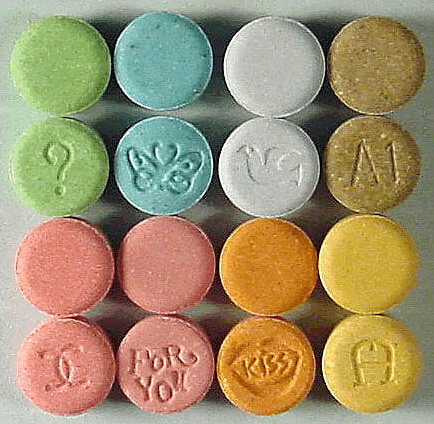 Ecstasy, also called MDMA, thizzle, skittles, rolling, etc is a semi-synthetic chemical compound. In its pure form, it is a white crystalline powder. It is usually seen in capsule form, in pressed pills, or as loose powder. The average cost ranges from $10-$30 ( U.S.) a dose. The most common routes of administration are swallowing or snorting, although it can be smoked or injected as well. Currently, Ecstasy is on the U.S. Schedule I of controlled substances, and is illegal to manufacture, possess, or sell in the United States. Most other countries have similar laws.
Ecstasy, also called MDMA, thizzle, skittles, rolling, etc is a semi-synthetic chemical compound. In its pure form, it is a white crystalline powder. It is usually seen in capsule form, in pressed pills, or as loose powder. The average cost ranges from $10-$30 ( U.S.) a dose. The most common routes of administration are swallowing or snorting, although it can be smoked or injected as well. Currently, Ecstasy is on the U.S. Schedule I of controlled substances, and is illegal to manufacture, possess, or sell in the United States. Most other countries have similar laws.
Ecstasy is a psychoactive drug possessing stimulant and hallucinogenic properties. It possesses chemical variations of the stimulant amphetamine or methamphetamine and a hallucinogen, most often mescaline. Ecstasy was first synthesized in 1912 by a German company possibly to be used as an appetite suppressant. Chemically, it is an analogue of MDA, a drug that was popular in the 1960s. In the late 1970s, Ecstasy (MDMA) was used to facilitate psychotherapy by a small group of therapists in the United States. Ecstasy use was not popular until the late 1980s and early 1990s.
Ecstasy is taken orally, usually in tablet or capsule form. The effects of ecstasy last approximately four to six hours. Users of the drug say that it produces profoundly positive feelings, empathy for others, elimination of anxiety, enhancement of the senses, and extreme relaxation. Ecstasy is also said to suppress the need to eat or sleep, enabling users to endure two- to three-day parties. Consequently, ecstasy use sometimes results in severe dehydration or exhaustion. While it is not as addictive as heroin or cocaine, ecstasy can cause other adverse effects including nausea, hallucinations, chills, sweating, increases in body temperature, tremors, involuntary teeth clenching, muscle cramping, and blurred vision. Ecstasy users also report aftereffects of anxiety, paranoia, and depression. An ecstasy overdose is characterized by high blood pressure, faintness, and panic attack. A more severe overdose can cause loss of consciousness, seizures, and a drastic rise in body temperature. Ecstasy overdoses can be fatal, as they may result in heart failure or extreme heat stroke.
The most common location for ecstasy use are late-night parties called “raves,” nightclubs, and rock concerts. As the rave and club scene expands to metropolitan and suburban areas across the country, ecstasy use and distribution are increasing as well. Ecstasy is often used in combination with other substances. Once a person begins using ecstasy or begins frequenting events where ecstasy is widely used, a vast array of drugs become accessible as well. Ecstasy users often seek to increase their high by combining their pill with a dose of marijuana, LSD, ketamine, GHB, amphetamines, cocaine, or heroin. Often times this experimentation can lead to addiction.
